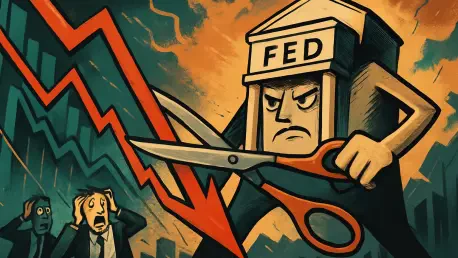The Federal Reserve’s ongoing effort to shrink its massive balance sheet through quantitative tightening (QT) has reached a critical juncture, with money market volatility raising alarms across Wall Street. With repo borrowing costs climbing and unexpected reliance on the Fed’s emergency facilities, the central bank faces a daunting challenge: continue reducing its holdings or pause to prevent further rate turbulence. This roundup dives into diverse perspectives from analysts and industry leaders, exploring whether the Fed might halt QT as early as the upcoming October Federal Open Market Committee (FOMC) meeting. The goal is to synthesize varying opinions on market pressures, policy timing, and the broader implications for monetary stability, offering a comprehensive view of this pivotal moment in financial policy.
Market Pressures Fuel Debate on QT’s Future
Signs of Strain in Short-Term Lending Markets
Recent turbulence in money markets has sparked intense discussion among financial experts about the sustainability of the Fed’s QT strategy. Rising borrowing costs in the repo market, coupled with spikes in the Secured Overnight Financing Rate (SOFR), have signaled potential liquidity shortages that could undermine the central bank’s control over interest rates. Many analysts point to these indicators as urgent warnings that continuing the balance sheet drawdown without adjustment risks deeper disruptions.
Beyond these metrics, unexpected usage of the Fed’s Standing Repo Facility has added another layer of concern. Industry observers note that such reliance suggests banks and financial institutions are struggling to secure funding under current conditions. This strain has led to a growing chorus of voices urging the Fed to reassess its approach before short-term rates spiral further out of alignment with policy targets.
The complexity of these issues lies in pinpointing the root cause of the friction. While QT is often cited as a primary driver, some market watchers argue that external factors, such as large Treasury auctions, may also contribute to the volatility. This ambiguity fuels the ongoing debate over whether a pause in QT would fully address the underlying stress or merely mask broader systemic challenges.
Predictions for an Imminent Policy Shift
Turning to the timeline for potential action, a significant number of analysts anticipate a turning point at the October FOMC meeting. Forecasts from various financial institutions suggest the Fed could signal or implement a halt to QT within weeks, driven by the mounting evidence of market strain. This expectation reflects a broader consensus that delaying action might exacerbate rate volatility and erode confidence in monetary policy.
Divergent views emerge on the specifics of this potential pause. Some industry leaders predict a complete cessation of securities runoffs by year-end, aiming to stabilize liquidity before seasonal pressures intensify. Others propose a more gradual approach, suggesting that certain assets, like mortgage bonds, might continue to roll off at a reduced pace due to sluggish dynamics in the housing sector, highlighting the nuanced considerations at play.
The risks of timing also weigh heavily in these discussions. Acting too soon could leave excess liquidity in the system, potentially fueling inflationary pressures, while waiting too long might deepen existing frictions in funding markets. This delicate balance underscores the high stakes of the Fed’s next steps and the varied opinions on how best to navigate them.
Liquidity Challenges and the Search for Balance
Defining Adequate Liquidity Levels
A central theme in the QT debate is the Fed’s elusive target of achieving the “right amount” of liquidity in the financial system. Banking reserves, currently hovering around $3 trillion, are viewed by some policymakers as nearing a sufficient level to support market functioning. However, analysts caution that this benchmark remains fluid, shaped by evolving economic conditions and unexpected demand for cash.
Regional banking dynamics further complicate the picture, as smaller institutions often face tighter constraints than their larger counterparts. Seasonal factors, such as tax payment deadlines, also create temporary surges in liquidity needs that can distort the Fed’s calculations. These variables highlight the difficulty of establishing a universal threshold for reserves that works across all market participants.
Questions persist about whether current metrics truly reflect adequate liquidity or if the Fed risks misjudging the tipping point. Some industry experts argue that over-reliance on aggregate figures might obscure pockets of stress, urging a more granular approach to policy adjustments. This perspective adds a critical dimension to the ongoing analysis of QT’s endgame.
External Forces Impacting QT Decisions
Beyond the mechanics of QT, a range of external factors are shaping expert opinions on the Fed’s strategy. Increased Treasury bill issuance, for instance, has been flagged as a contributor to rate turbulence, absorbing liquidity that might otherwise ease market pressures. Idiosyncratic events, such as large corporate transactions or regulatory shifts, also play a role in disrupting short-term funding dynamics.
Analyst timelines for a QT pause vary partly due to these broader influences. While many foresee an announcement in October, more conservative forecasts push the decision to early next year, citing the need for clearer data on these external drivers. Such differences reflect the challenge of isolating QT’s impact amid a web of interconnected market forces.
Speculation abounds on how a QT halt might influence investor sentiment and long-term interest rate expectations. Some market observers suggest that a pause could bolster confidence by signaling the Fed’s responsiveness, while others warn of potential misinterpretations that might fuel uncertainty. These contrasting views enrich the dialogue on the policy’s wider ramifications.
Key Takeaways from Diverse Perspectives
Synthesizing the insights gathered, a near-unanimous expectation emerges among analysts that the Fed will pause QT soon, with many pinpointing the October meeting as a likely inflection point. The driving force behind this consensus is the evident friction in money markets, from elevated repo costs to SOFR fluctuations, which collectively threaten the central bank’s grip on interest rates. This urgency unites opinions across financial institutions, despite minor variances in projected timelines.
Differences in approach surface when examining the specifics of implementation. While some advocate for an abrupt end to all securities runoffs, others favor a phased reduction, particularly for mortgage-backed assets tied to the housing market’s unique challenges. These distinctions reveal the layered considerations the Fed must weigh, balancing immediate stability with longer-term economic goals.
For investors and financial professionals, staying attuned to repo market trends and parsing Fed communications for subtle hints of policy shifts remain critical. Adjusting portfolio allocations to brace for potential rate stabilization—or further volatility—offers a practical response to the uncertainty. Monitoring upcoming FOMC statements could provide early clues on the direction of QT, guiding strategic decisions in a fluid environment.
Reflecting on the Fed’s Path Forward
Looking back on the discussions surrounding the Federal Reserve’s QT policy, it becomes clear that analysts and industry leaders largely coalesce around the need for a near-term pause, driven by mounting liquidity pressures. The October FOMC meeting stands out as a focal point for many, with market turbulence serving as a catalyst for reevaluating the balance sheet drawdown. Diverse perspectives on timing and execution enrich the debate, painting a complex picture of monetary policy at a crossroads.
Moving forward, stakeholders are encouraged to delve deeper into money market indicators as a barometer of the Fed’s next moves. Engaging with detailed analyses from financial institutions could offer additional clarity on how a QT halt might reshape interest rate trajectories. Exploring historical precedents of balance sheet normalization might also provide valuable context, equipping market participants to navigate the evolving landscape with greater confidence.









